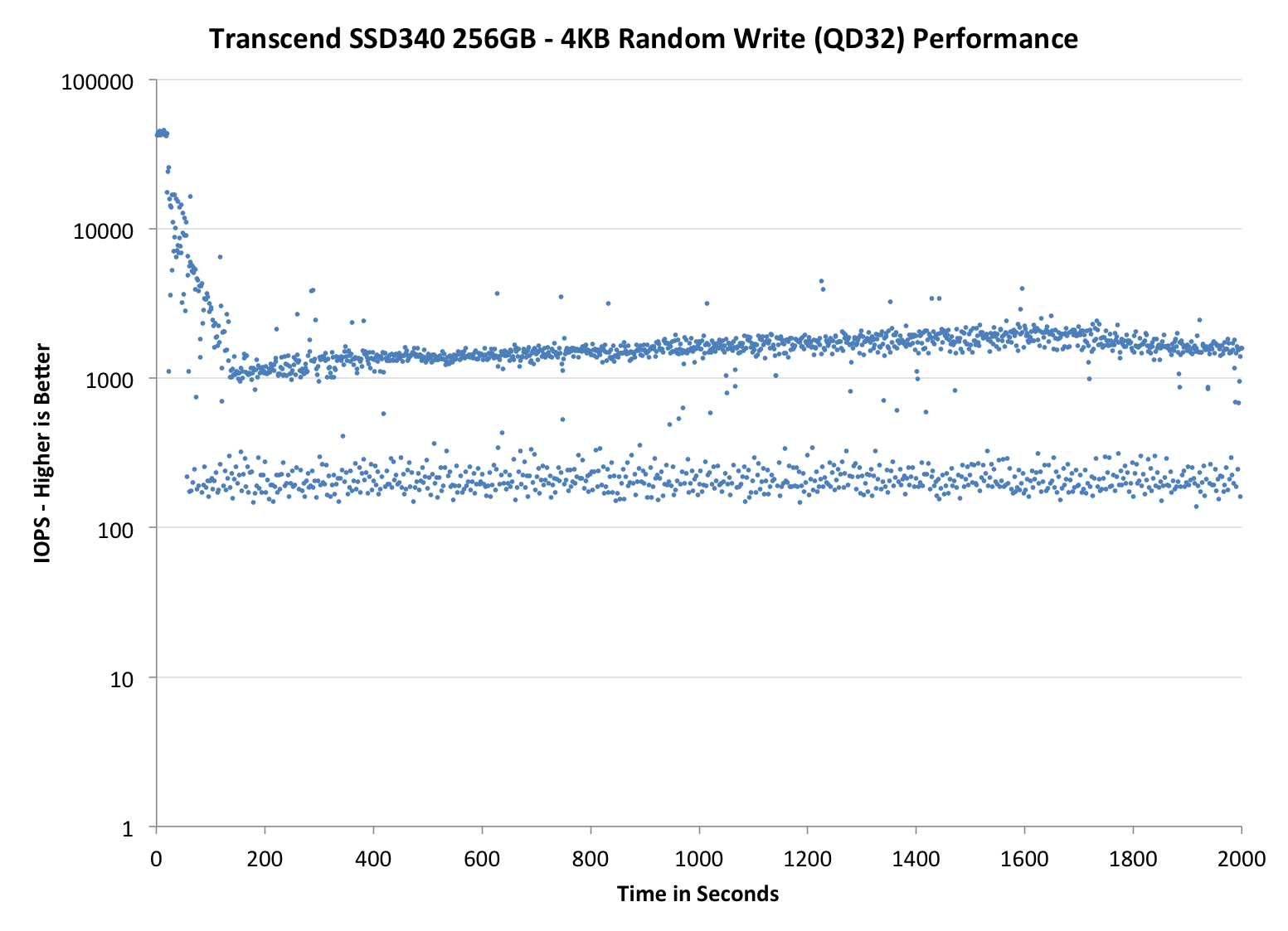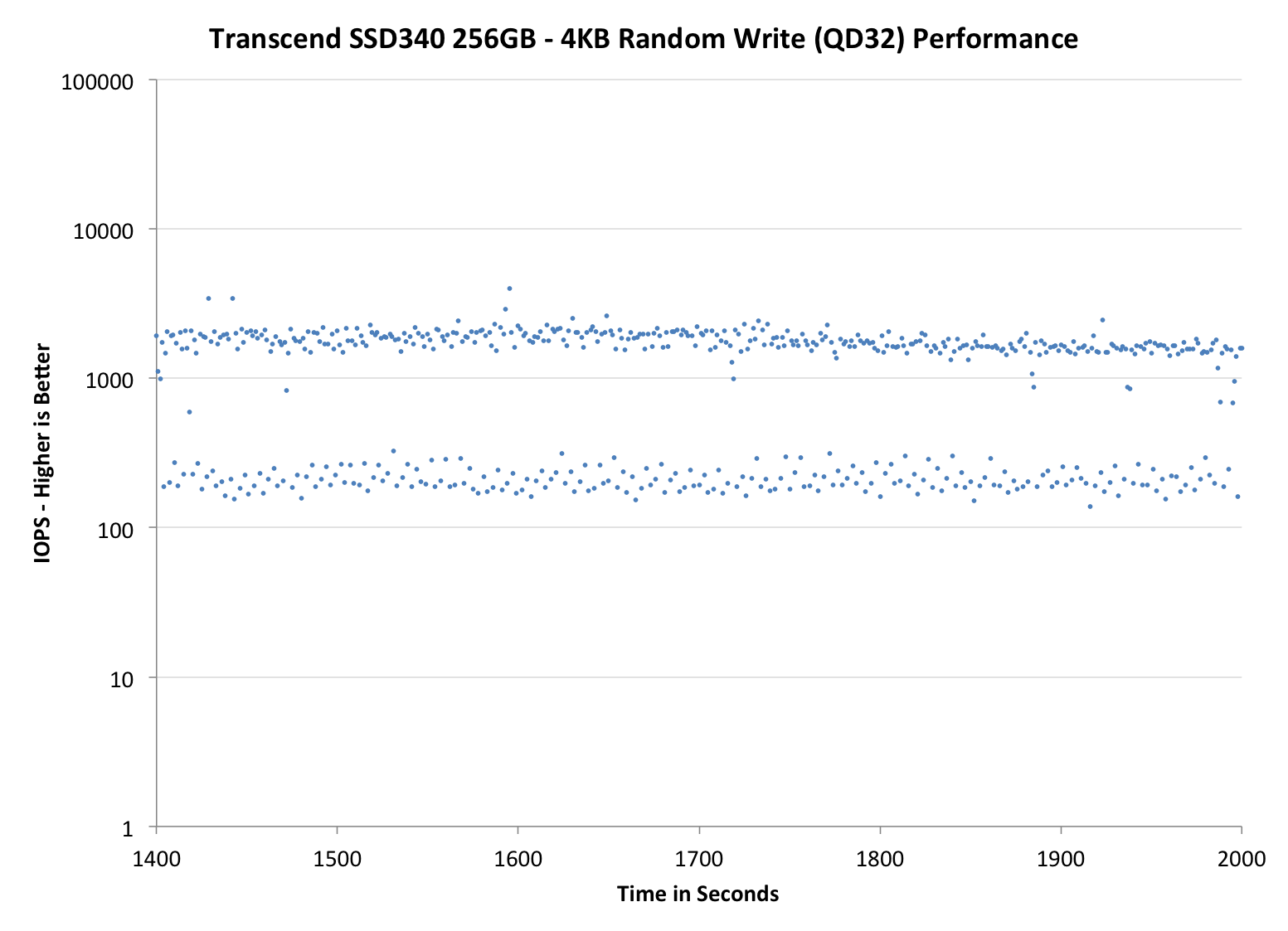Transcend SSD340 (256GB) Review
by Kristian Vättö on August 4, 2014 5:00 AM ESTPerformance Consistency
Performance consistency tells us a lot about the architecture of these SSDs and how they handle internal defragmentation. The reason we do not have consistent IO latency with SSDs is because inevitably all controllers have to do some amount of defragmentation or garbage collection in order to continue operating at high speeds. When and how an SSD decides to run its defrag or cleanup routines directly impacts the user experience as inconsistent performance results in application slowdowns.
To test IO consistency, we fill a secure erased SSD with sequential data to ensure that all user accessible LBAs have data associated with them. Next we kick off a 4KB random write workload across all LBAs at a queue depth of 32 using incompressible data. The test is run for just over half an hour and we record instantaneous IOPS every second.
We are also testing drives with added over-provisioning by limiting the LBA range. This gives us a look into the drive’s behavior with varying levels of empty space, which is frankly a more realistic approach for client workloads.
Each of the three graphs has its own purpose. The first one is of the whole duration of the test in log scale. The second and third one zoom into the beginning of steady-state operation (t=1400s) but on different scales: the second one uses log scale for easy comparison whereas the third one uses linear scale for better visualization of differences between drives. Click the buttons below each graph to switch the source data.
For more detailed description of the test and why performance consistency matters, read our original Intel SSD DC S3700 article.
 |
|||||||||
| Transcend SSD340 | JMicron JMF667H (Toshiba NAND) | JMicron JMF667H (IMFT NAND) | Samsung SSD 840 EVO mSATA | Crucial MX100 | |||||
| Default | |||||||||
| 25% OP | |||||||||
Right from the start, things do not look too promising. Compared to the reference design with the same IMFT NAND, the IO consistency is considerably lower. The reference design manages around 1,000 IOPS minimum, whereas in the SSD340 the minimum performance is around 300 IOPS. Increasing the over-provisioning helps by a bit but the consistency is still poor compared to the other value drives (like the MX100). The older firmware definitely isn't doing Transcend any favors here – quite the opposite in fact.
 |
|||||||||
| Transcend SSD340 | JMicron JMF667H (Toshiba NAND) | JMicron JMF667H (IMFT NAND) | Samsung SSD 840 EVO mSATA | Crucial MX100 | |||||
| Default | |||||||||
| 25% OP | |||||||||
 |
|||||||||
| Transcend SSD340 | JMicron JMF667H (Toshiba NAND) | JMicron JMF667H (IMFT NAND) | Samsung SSD 840 EVO mSATA | Crucial MX100 | |||||
| Default | |||||||||
| 25% OP | |||||||||
TRIM Validation
To test TRIM, I first filled all user-accessible LBAs with sequential data and continued with torturing the drive with 4KB random writes (100% LBA, QD=32) for 30 minutes. After the torture I TRIM'ed the drive (quick format in Windows 7/8) and ran HD Tach to make sure TRIM is functional.
And it is.











57 Comments
View All Comments
TonyCL6 - Wednesday, August 6, 2014 - link
SSD370 should be pretty much the same as AData SP610 because of the controller and NAND configuration.Per Hansson - Monday, August 4, 2014 - link
The more things change the more they stay the same seems a fitting quote for this Transcend's SSD endeavors!homerdog - Monday, August 4, 2014 - link
Unless these drives fall way down the price ladder, there simply no reason for them to exist.MadMan007 - Monday, August 4, 2014 - link
Is there any budget SSD that makes sense in a world where the MX100 exists?Samus - Monday, August 4, 2014 - link
This drive (and this company) is completely irrelevant. I don't get why anybody would buy a drive outside of the Crucial/Micron/Intel/Samsung/Toshiba/Sandisk circle.Kingston, ADATA, Transcend, OWC, Mushkin, Corsair, and so on, make no compelling products and can't compete with Sandisk/Crucial on price because they don't make their own memory, controllers, or both.
hojnikb - Tuesday, August 5, 2014 - link
Pretty much. Unless you're owning a fab it's pretty hard to compete price wise.TonyCL6 - Wednesday, August 6, 2014 - link
Frankly for consumer market, only Samsung and maybe Toshiba has its own SSD controllers. The rest are now mainly using Marvell solutions. Kingston, ADATA, Transcend, OWC, Mushkin, Corsair and so on help Micron(Intel) and Toshiba(Sandisk) a lot to support/ consume their NAND Flash capacity. If they all gone, I personally don't think that would do any good to end-users. You can easily tell from how Samsung sells TLC and VNAND products. The cost of NAND is way much cheaper but that never reflects on the selling price.l_d_allan - Tuesday, August 5, 2014 - link
As Butch Cassidy said, "Don't sugar-coat it" :-)StrangerGuy - Tuesday, August 5, 2014 - link
Anandtech should just probably come blunt and say "If you can't beat the MX100 in price/performance/reliability don't even THINK about selling consumer SSDs thank you very much"Readers that visit this site ain't fooled no matter how much ads or exposure that comes down our throats.
hojnikb - Tuesday, August 5, 2014 - link
But its true. Why buy a turd, if you can speds a few extra bucks and get a proper drive.